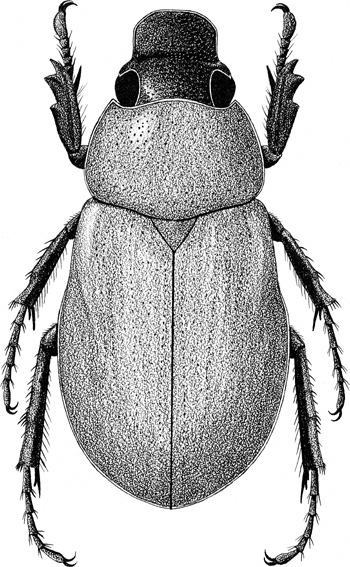 |
|||||||
|
|||||||
|
||
|
||
| Dynastinae Taxa Map | ||
........Paraspidolea Höhne 1922a: 90 (synonym).
Distribution: From Mexico to Argentina (Martínez 1975; Ratcliffe 1977; Endrödi 1985a; Dechambre 1992a).
Composition: 25 species.
Diagnosis: Species of Aspidolea are extremely close in overall appearance to those of Cyclocephala. In Aspidolea, the maxilla is penicillate at the apex instead of being armed with teeth (except in A. fuliginea Burmeister). Some species of Cyclocephala also have a penicillate maxilla (e.g., C. pardolocarnoi Dechambre), but the maxilla is also heavily armed with teeth. Species of Ancognatha also have an unarmed maxilla, but the form of the maxilla is elongate and robust, unlike that of Aspidolea.
Endrödi (1966, 1985a) relied on the form of the clypeus of Aspidolea species to separate them from species of Cyclocephala. In Aspidolea, the sides of the clypeus are usually divergent (sometimes only slightly) from the base, and the apex is broadly rounded. In species of Cyclocephala, the sides at the base of the clypeus are parallel or convergent from the base but never divergent; the apex may be rounded, subtruncate, or emarginate. This difference in the form of the base of the clypeus is often subtle and difficult to ascertain, especially without comparative material or experience with this group. This is not a good character, by itself, for separating the two genera, but it does have utility in a key if used with caution. The presence or absence of teeth on the maxilla is a better character, but, in those species of Cyclocephala with a penicillate maxilla, the teeth are often very difficult to see because of the dense setae comprising the penicillum, and so determining whether the beetle is Aspidolea or Cyclocephala may be difficult. In Aspidolea species, the antenna is 10-segmented, and the club is always short (i.e., subequal to or shorter than the stem). Males have the protarsus enlarged.
Larvae: Larval stages remain undescribed for species of Aspidolea.
Biological notes: Similarly, life history information is lacking other than adults are attracted to lights at night.
Revision or synopsis: Endrödi (1966, 1985a) reviewed the species of Aspidolea, and several new species have been described since that time.
Literature cited:
Dechambre, R.-P. 1992a. Nouveaux Cyclocephalini des genres Cyclocephala et Aspidolea (Col. Dynastidae), pp. 57-76. In Lachaume, G., Les Coléoptères du Monde 14: Dynastidae Américains. Sciences Nat, Venette, France. 87 pp., 13 plates.
Endrödi, S. 1966. Monographie der Dynastinae (Coleoptera, Lamellicornia). I. Teil. Entomologische Abhandlungen 33: 1-460.
Endrödi, S. 1985a. The Dynastinae of the World. Dr. W. Junk Publisher, Dordrecht. 800 pp., 46 plates.Martínez, A. 1975. Una nueva especie de Aspidolea de Ecuador (Col. Scarabaeidae, Dynastinae). Entomologische Arbeiten aus dem Museum G. Frey 26: 307-313.
Ratcliffe, B. C. 1977. Four new species of Neotropical Cyclocephalini (Coleoptera: Scarabaeidae). Acta Amazonica 7: 429-434.
|
||||
|
|
